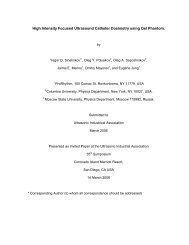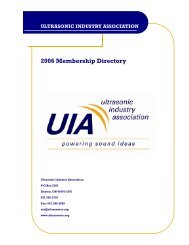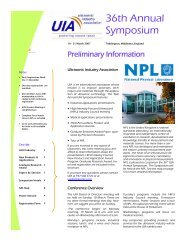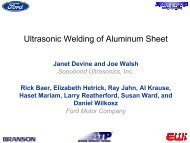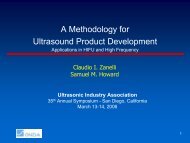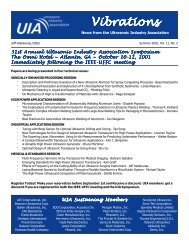2012 Spring issue of Vibrations (pdf) - Ultrasonic Industry Association
2012 Spring issue of Vibrations (pdf) - Ultrasonic Industry Association
2012 Spring issue of Vibrations (pdf) - Ultrasonic Industry Association
Create successful ePaper yourself
Turn your PDF publications into a flip-book with our unique Google optimized e-Paper software.
Volume 22, Issue 2<br />
Page 5<br />
Symposium Technical Program, Continued<br />
Figure 3. Solid model and photograph <strong>of</strong> an assembled flexure<br />
horn (Ti-6Al-4V) manufactured using (Electron Beam Melting/<br />
Manufacturing (EBM). (Stewart Sherrit, Xiaoqi Bao, Mircea<br />
Badescu, , Phillip Allen, Yoseph Bar-Cohen, “Monolithic Rapid<br />
Prototyped Flexured <strong>Ultrasonic</strong> Horns”, Proceedings <strong>of</strong> the IEEE<br />
International <strong>Ultrasonic</strong>s Symposium, pp. 886-889 , Presented in<br />
San Diego, CA, October 2010). Courtesy <strong>of</strong> JPL/Caltech/NASA<br />
.<br />
We are fortunate this year to be able to form a<br />
segment <strong>of</strong> papers related to novel horns, as these are<br />
enabling technologies for both extraterrestrial and<br />
terrestrial applications. Often, the basis modeling<br />
techniques and technologies are <strong>of</strong> general interest to<br />
ultrasonic industry participants, and presently alternate<br />
wave modes such as longitudinal-torsional and<br />
transverses motion are <strong>of</strong> great interest.<br />
University <strong>of</strong> Glasgow will present two papers on<br />
topics related to research <strong>of</strong> Dr. Stewart Sherrit on<br />
planetary drilling. Dr. Sherrit’s systems use longitudinal-torsional<br />
vibration to provide rotation to a cutting<br />
bit during ultrasonic-sonic drilling, and Mr. Hassan Al-<br />
Budairi will describe his work on optimization <strong>of</strong> degenerate<br />
longitudinal horns which produce precisely<br />
this output. The horns developed by Mr. Al-Budairi<br />
generate this vibration by developing the path <strong>of</strong> the<br />
longitudinal resonant wave, which means that simple<br />
Langevin transducers can be used instead <strong>of</strong> more<br />
complex tangentially-poled or mode-coupling approaches.<br />
Dr. Patrick Harkness will describe an adap-<br />
Figure 4. Solid model and photograph <strong>of</strong> finished transducer<br />
for hammering and rotating a work piece. (L.N. Domm, Y.<br />
Bar-Cohen, S. Sherrit, JPL USRP student final report, http://<br />
usrp.usra.edu/technicalPapers/jpl/DommMay11.<strong>pdf</strong> ). Courtesy<br />
<strong>of</strong> JPL/Caltech/NASA<br />
tation <strong>of</strong> this technique which separates the longitudinal<br />
and torsional outputs into two separate output surfaces<br />
<strong>of</strong> a specialist horn. This is significant because, if successful,<br />
it provides a mechanism by which rotation and<br />
percussion can be separated in ultrasonic-sonic drilling,<br />
which would in turn enable switchable outputs and a<br />
potential reduction in systemic problems such as bitwalk<br />
during coring operations.<br />
Figure 5 on page 6 shows an ultrasonic drill on trial by<br />
University <strong>of</strong> Glasgow.



